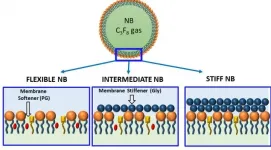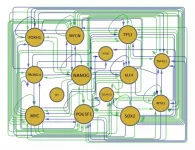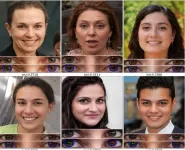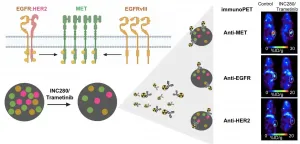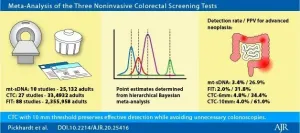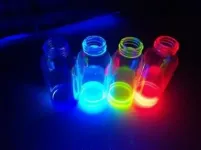(Press-News.org) If you were given "ultrasound" in a word association game, "sound wave" might easily come to mind. But in recent years, a new term has surfaced: bubbles. Those ephemeral, globular shapes are proving useful in improving medical imaging, disease detection and targeted drug delivery. There's just one glitch: bubbles fizzle out soon after injection into the bloodstream.
Now, after 10 years' work, a multidisciplinary research team has built a better bubble. Their new formulations have resulted in nanoscale bubbles with customizable outer shells -- so small and durable that they can travel to and penetrate some of the most inaccessible areas in the human body.
The work is a collaboration between Al C. de Leon and co-authors, under the supervision of Agata A. Exner of the Department of Radiology at the Case Western Reserve University School of Medicine in Cleveland and Amin Jafari Sojahrood under the supervision of Michael Kolios of the Department of Physics at Ryerson University and the Institute for Biomedical Engineering, Science and Technology (iBEST) in Toronto. Their results were recently published in ACS Nano, in a paper entitled "Towards Precisely Controllable Acoustic Response of Shell-Stabilized Nanobubbles: High-Yield and Narrow-Dispersity".
"The advancement can eventually lead to clearer ultrasound images," says Kolios. "But more broadly, our joint theoretical and experimental findings provide a fundamental framework that will help establish nanobubbles for applications in biomedical imaging -- and potentially into other fields, from material science to surface cleaning and mixing."
Bubbles in Ultrasound: Shrinking Down to Nanoscale
Ultrasound is the second most used medical imaging modality in the world. As with other modalities, a patient may swallow or be injected with an agent to create image contrast, thereby making bodily structures or fluids easier to see.
With ultrasound, bubbles serve as the contrast agent. These gas-filled globes are enclosed by a phospholipid shell. Contrast is generated when ultrasound waves interact with the bubbles, causing them to oscillate and reflect soundwaves that differ significantly from waves reflected by body tissues. Bubbles are used routinely in patients to improve image quality and enhance the detection of diseases. But due to their size (about the same as red blood cells), microbubbles are confined to circulating in blood vessels, and cannot reach diseased tissue outside.
"Our research team at CWRU now engineered stable, long-circulating bubbles at the nanoscale -- measuring 100-500 nm in diameter," says Exner. "They're so that they can even squeeze through leaky vasculature of cancerous tumours."
With such capabilities, nanobubbles are well-suited for finer applications such as molecular imaging and targeted drug delivery. Working together with the Ryerson team, the researchers have developed a clearer understanding of the theory of how nanobubbles are visualized with ultrasound, and what imaging techniques are needed to best visualize the bubbles in the body.
Controlling Nanobubble Behaviour
Size issues aside, bubbles are also complex oscillators, exhibiting behaviours that are difficult to control. In the current work, the research team also devised a way to precisely control and predict how bubbles interact with and respond acoustically to ultrasound.
"By introducing membrane additives to our bubble formulations, we demonstrated the ability to control how stiff (or how flexible) the bubble shells become," says de Leon. "Bubble formulations can then be customized to match the particular needs of different applications."
For example, stiffer, stable bubble designs may last long enough to reach body tissues that are difficult to access. Softer bubbles may produce clearer ultrasound images of certain types of body tissue. Bubble oscillation could even be tweaked to increase cell permeability, potentially increasing drug delivery to diseased cells, which may in turn decrease the dosage required.
Patients, the Ultimate Beneficiaries
Having successfully demonstrated the ability to customize bubble shell properties and their interaction with sound waves, the current work has exciting implications for nanobubble potency -- in both diagnostic and therapeutic applications.
Sojahrood sees many potential benefits, for biomedicine and for patients in clinic. "Compared to other imaging or treatment options, such as surgery with scalpels, bulky MRI machinery, or the risk of radioactive iodine in CT scans, ultrasound could be a lot faster, cheaper, more effective and less invasive," he says. "By advancing ultrasound through nanobubbles, we could eventually make diagnosis and treatment more available and more effective, even in more remote areas of the world, ultimately improving patient outcomes and saving more lives."
INFORMATION:
Research reported in this publication was supported by:
National Institute of Biomedical Imaging and Bioengineering of the National Institutes of Health under award number R01EB025741
Office of the Assistant Secretary of Defense for Health Affairs, through the Prostate Cancer research program under award no. W81XWH-16-1-0371
Case Western Reserve University Coulter Translational Partnership
A.J.S. was supported by a CIHR Vanier scholarship
M.C.K. and A.S. received support from the CIHR and NSERC
P.W. and E.P. received financial support from NSF CAREER award no. 1551943. A.d.L
A.E. would like to acknowledge the help from Olive Jung
(BOSTON) -- There is a great need to generate various types of cells for use in new therapies to replace tissues that are lost due to disease or injuries, or for studies outside the human body to improve our understanding of how organs and tissues function in health and disease. Many of these efforts start with human induced pluripotent stem cells (iPSCs) that, in theory, have the capacity to differentiate into virtually any cell type in the right culture conditions. The 2012 Nobel Prize awarded to Shinya Yamanaka recognized his discovery of a strategy that can reprogram adult cells to become iPSCs ...
Arlington, Va. (March 12, 2021)--A new supplement offering guidance on severe COVID-19 management in resource-limited settings is now available on the American Journal of Tropical Medicine (AJTMH) website. Pragmatic Recommendations for the Management of Hospitalized COVID-19 Patients in Low- and Middle-Income Countries was coordinated by a COVID-LMIC Task Force headed by Alfred Papali, MD, of Atrium Health, Charlotte, NC, and Marcus Schultz, MD, PhD, of Mahidol University, Bangkok, Thailand; University of Oxford, United Kingdom; and Amsterdam University Medical Centers, The Netherlands. ...
BUFFALO, N.Y. - University at Buffalo computer scientists have developed a tool that automatically identifies deepfake photos by analyzing light reflections in the eyes.
The tool proved 94% effective in experiments described in a paper accepted at the IEEE International Conference on Acoustics, Speech and Signal Processing to be held in June in Toronto, Canada.
"The cornea is almost like a perfect semisphere and is very reflective," says the paper's lead author, Siwei Lyu, PhD, SUNY Empire Innovation Professor in the Department of Computer Science and Engineering. "So, anything that is coming to the eye with a light emitting from those sources will have an image on ...
Reston, VA--Immuno-positron emission tomography (PET) imaging can provide early insight into a tumor's response to targeted therapy, allowing physicians to select the most effective treatment for patients who have cancer. The new research was published in the March issue of The Journal of Nuclear Medicine.
The research showed that immuno-PET successfully visualizes changes in different cancer receptors (receptor tyrosine kinases, or RTKs) within tumors during targeted therapies. This gives physicians a tool that can be used to evaluate the effectiveness of a treatment soon after its administration.
"When healthy cells turn into cancer cells, there is a disruption in the RTK signaling. This makes RTKs a valuable therapeutic and ...
Leesburg, VA, March 12, 2021--According to an open-access article in ARRS' American Journal of Roentgenology (AJR), compared with multi-target stool-DNA (mt-sDNA) and fecal immunochemical test (FIT), CT colonography (CTC) with 10 mm threshold most effectively targets advanced neoplasia (AN)--preserving detection while decreasing unnecessary colonoscopies.
"CTC performed with a polyp size threshold for colonoscopy referral set at 10 mm represents the most effective and efficient non-invasive screening test for colorectal cancer (CRC) prevention and detection," clarified first author Perry J. Pickhardt from the department of radiology ...
UNIVERSITY PARK, Pa. -- Did you ever wonder how social networking applications like Facebook and LinkedIn make recommendations on the people you should friend or pages you should follow?
Behind the scenes are machine learning models that classify nodes based on the data they contain about users -- for example, their level of education, location or political affiliation. The models then use these classifications to recommend people and pages to each user. But there is significant bias in the recommendations made by these models -- known as graph neural networks (GNNs) ...
A new study by UC Davis MIND Institute researchers suggests that executive control differences in autism spectrum disorder (ASD) may be the result of a unique approach, rather than an impairment.
Executive control difficulties are common in individuals with autism and are associated with challenges completing tasks and managing time. The study, published in Biological Psychiatry: Cognitive Neuroscience and Neuroimaging, sought to tease out whether these difficulties represent a disruption in proactive executive control (engaged and maintained before a ...
Quantum dots are manmade nanoparticles of semiconducting material comprising only a few thousand atoms. Because of the small number of atoms, a quantum dot's properties lie between those of single atoms or molecules and bulk material with a huge number of atoms. By changing the nanoparticles' size and shape, it is possible to fine-tune their electronic and optical properties - how electrons bond and move through the material, and how light is absorbed and emitted by it.
Thanks to increasingly refined control of the nanoparticles' size and shape, the number ...
A machine learning algorithm that predicts suicide attempt recently underwent a prospective trial at the institution where it was developed, Vanderbilt University Medical Center.
Over the 11 consecutive months concluding in April 2020, predictions ran silently in the background as adult patients were seen at VUMC. The algorithm, dubbed the Vanderbilt Suicide Attempt and Ideation Likelihood (VSAIL) model, uses routine information from electronic health records (EHRs) to calculate 30-day risk of return visits for suicide attempt, and, by extension, suicidal ideation.
Suicide has been on the rise in the U.S. for a generation ...
What The Study Did: Researchers investigated whether acute COVID-19 symptoms are associated with the probability of subsequent depressive symptoms.
Authors: Roy H. Perlis, M.D., M.Sc., of the Massachusetts General Hospital in Boston, is the corresponding author.
To access the embargoed study: Visit our For The Media website at this link https://media.jamanetwork.com/
(doi:10.1001/jamanetworkopen.2021.3223)
Editor's Note: Editor's Note: The article includes conflict of interest and funding/support disclosures. Please see the article for additional information, ...
